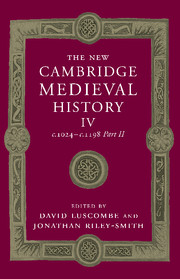Book contents
- Frontmatter
- 1 Introduction
- 2 The papacy, 1024–1122
- 3 The western empire under the Salians
- 4 Italy in the eleventh century
- 5 The kingdom of the Franks to 1108
- 6 Spain in the eleventh century
- 7 England and Normandy 1042–1137
- 8 The Byzantine Empire, 1025–1118
- 9 Kievan Rus’, the Bulgars and the southern Slavs, c. 1020 – c. 1200
- 10 Poland in the eleventh and twelfth centuries
- 11 Scandinavia in the Eleventh and Twelfth Centuries
- 12 Hungary in the Eleventh and Twelfth Centuries
- 13 The papacy, 1122–1198
- 14 The western empire, 1125–1197
- 15 Italy in the twelfth century
- 16 Spain in the twelfth century
- 17 The kingdom of the Franks from Louis VI to Philip II
- 18 England and the Angevin dominions, 1137–1204
- 19 Scotland, Wales and Ireland in the Twelfth Century
- 20 The Byzantine Empire, 1118–1204
- 21 The Latin East, 1098–1205
- 22 ’Abbasids, Fatimids and Seljuqs
- 23 Zengids, Ayyubids and Seljuqs
- Appendix: genealogical tables
- List of primary sources
- Bibliography of Secondary Works Arranged by Chapter
- Index
- Map 1a The western empire: Burgundy and Provence in the eleventh century"
- Map 1b The western empire: Germany and the north-eastern frontier of Christendom in the eleventh century"
- Map 3 The kingdom of the Franks"
- Map 4 England and Normandy"
- Map 10 Germany under Frederick Barbarossa, c. 1190">
- Map 12 The Angevin empire"
- References
14 - The western empire, 1125–1197
Published online by Cambridge University Press: 28 March 2008
- Frontmatter
- 1 Introduction
- 2 The papacy, 1024–1122
- 3 The western empire under the Salians
- 4 Italy in the eleventh century
- 5 The kingdom of the Franks to 1108
- 6 Spain in the eleventh century
- 7 England and Normandy 1042–1137
- 8 The Byzantine Empire, 1025–1118
- 9 Kievan Rus’, the Bulgars and the southern Slavs, c. 1020 – c. 1200
- 10 Poland in the eleventh and twelfth centuries
- 11 Scandinavia in the Eleventh and Twelfth Centuries
- 12 Hungary in the Eleventh and Twelfth Centuries
- 13 The papacy, 1122–1198
- 14 The western empire, 1125–1197
- 15 Italy in the twelfth century
- 16 Spain in the twelfth century
- 17 The kingdom of the Franks from Louis VI to Philip II
- 18 England and the Angevin dominions, 1137–1204
- 19 Scotland, Wales and Ireland in the Twelfth Century
- 20 The Byzantine Empire, 1118–1204
- 21 The Latin East, 1098–1205
- 22 ’Abbasids, Fatimids and Seljuqs
- 23 Zengids, Ayyubids and Seljuqs
- Appendix: genealogical tables
- List of primary sources
- Bibliography of Secondary Works Arranged by Chapter
- Index
- Map 1a The western empire: Burgundy and Provence in the eleventh century"
- Map 1b The western empire: Germany and the north-eastern frontier of Christendom in the eleventh century"
- Map 3 The kingdom of the Franks"
- Map 4 England and Normandy"
- Map 10 Germany under Frederick Barbarossa, c. 1190">
- Map 12 The Angevin empire"
- References
Summary
in 1122 the peace arranged at Worms between Pope Calixtus II and Emperor Henry V was designed to bring an end to the ecclesiastical, political and military emergencies which had disturbed the western empire since the 1070s, the series of confrontations called with hindsight the War of Investitures. The papal curia was enabled to return its attention to the programme of religious reform, and the First Lateran Council was celebrated in 1123. The emperor was freed from the incubus inherited from his excommunicated father Henry IV, and the preliminaries of the Worms pax committed the princes to assist the emperor in maintaining the authority and dignity of imperial rule. But the outcome of such intentions was problematical given the ingrained enmities, especially between Saxony and the royal court, caused by the War of Investitures. In any case the restoration of royal authority for which Henry V had striven since 1105 was called into question because the emperor, still a youngish man, died at Utrecht in May 1125. His marriage to Matilda of Normandy had proved childless, so it was necessary for the princes of the empire to set about electing a new king.
ELECTORAL PROCEDURES IN THE TWELFTH CENTURY
In the early summer of 1125 the German bishops and secular magnates who had gathered in Speyer for the obsequies of Henry V sent letters to the other princes of the empire inviting them to Mainz in August for the election of the next king. A surviving version, to Bishop Otto I of Bamberg, requested him to pray for a candidate who would liberate church and empire from the oppression under which they had laboured hitherto. Such explicit criticism of the two preceding emperors was undoubtedly the work of Archbishop Adalbert I of Mainz, whose office traditionally conferred upon the incumbent the leading voice in German royal elections.
Keywords
- Type
- Chapter
- Information
- The New Cambridge Medieval History , pp. 384 - 421Publisher: Cambridge University PressPrint publication year: 2004

